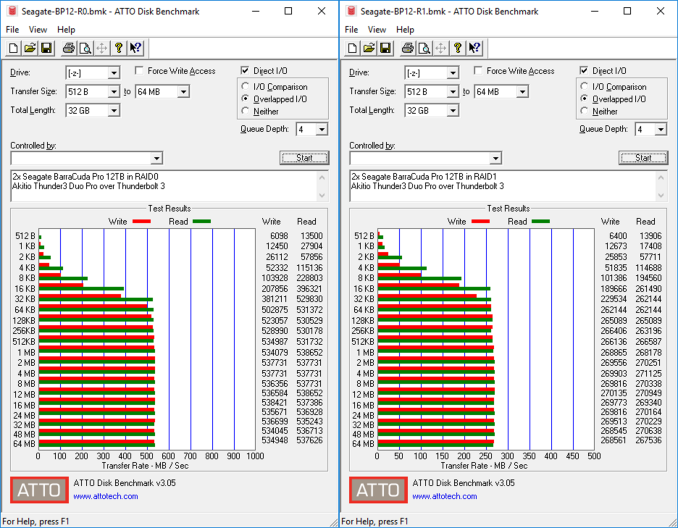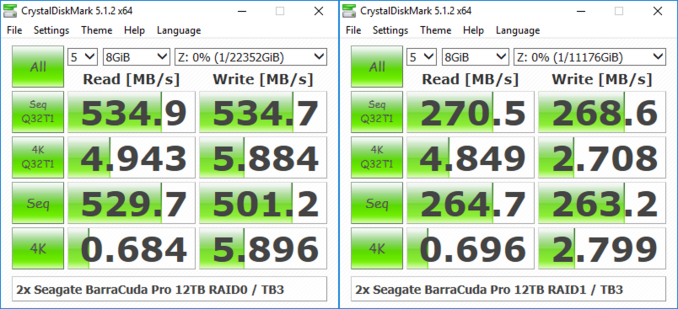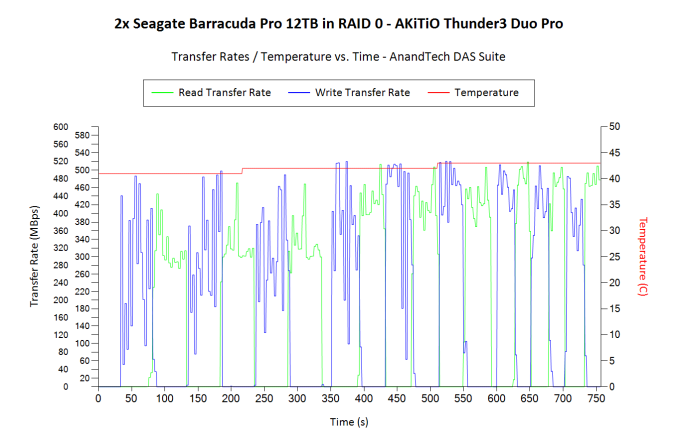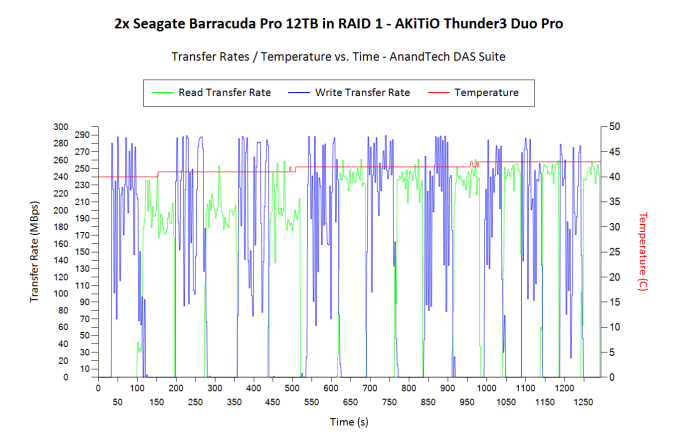Seagate BarraCuda Pro 12TB HDD Review
by Ganesh T S on November 15, 2017 8:00 AM EST- Posted in
- Storage
- Seagate
- HDDs
- Helium HDD
Performance - Direct Attached Storage Mode
Seagate suggests that the BarraCuda Pro Compute drives are suitable for use in direct-attached storage systems. We evaluated the performance in such a usage scenario using one of the highest performing 2-bay DAS units currently in the market - the Akitio Thunder3 Duo Pro, connected to our testbed via a Thunderbolt 3 interface.
Prior to processing real-life workloads, we first checked quick artificial access traces using ATTO and CrystalDiskMark.
We find that the performance remains consistent irrespective of workload size as long as the sequential access characteristic holds. Two drives in RAID 0 can sustain 530 MBps+ reads and writes. RAID 1 performance is similar to the standalone drive performance.
Both RAID0 and RAID1 configurations were subject to our standard DAS test suite described in the previous section. The robocopy test suite gave the following results.
| Akitio Thunder3 Duo Pro + 2x Seagate BarraCuda Pro 12TB (Thunderbolt 3) robocopy Benchmarks (MBps) |
||||
| Write Bandwidth | Read Bandwidth | |||
| RAID 0 | RAID 1 | RAID 0 | RAID 1 | |
| Photos | 334.00 | 215.79 | 303.85 | 184.12 |
| Videos | 432.76 | 221.45 | 396.39 | 222.44 |
| Blu-ray Folder | 421.10 | 219.98 | 434.73 | 224.72 |
There is no difference in the performance consistency between either RAID configuration. The behavior is largely similar to the internal drive scenario, except for the RAID 0 absolute bandwidth numbers. Thanks to the enclosure's fan, the temperature increase is also not as much as what we observed in the internal drive case.
We also processed select workloads from PCMark 8's storage bench.
| Akitio Thunder3 Duo Pro + 2x Seagate BarraCuda Pro 12TB (Thunderbolt 3) PCMark8 Storage Benchmarks (MBps) |
|||||
| Write Bandwidth | Read Bandwidth | ||||
| RAID 0 | RAID 1 | RAID 0 | RAID 1 | ||
| Adobe Photoshop (Light) | 313.76 | 201.22 | 10.51 | 9.16 | |
| Adobe Photoshop (Heavy) | 304.70 | 196.83 | 12.46 | 10.99 | |
| Adobe After Effects | 95.00 | 74.12 | 9.75 | 9.54 | |
| Adobe Illustrator | 214.10 | 168.92 | 9.39 | 9.11 | |
A significant speed-up in response time is achieved while dealing with multimedia files stored in a RAID 0 configuration of two BarraCuda Pro 12TB drives in a Thunderbolt 3 enclosure. Combined with the consistency shown, we can say that our results back up Segate's claims regarding the firmware tuning of BarraCuda Pro drives for specific application scenarios.














62 Comments
View All Comments
jabber - Thursday, November 16, 2017 - link
I would also say only fools tie themselves down with multi TB amounts of personal data. Data is a millstone round your neck.bigboxes - Friday, November 17, 2017 - link
RAID was not invented to protect your data. It's for uptime. You can live without RAID. Backup is essential for anything you value. RAID is not backup.piroroadkill - Wednesday, November 15, 2017 - link
I find it amusing that people are STILL saying this. When drives hit 500GB, 1TB, you name it, the same comment. Over, and over.You have a backup. Always have a backup.
blackcrayon - Thursday, November 16, 2017 - link
Exactly. Just double the price of every one of these drives in your head. You need two for backup.jordanclock - Wednesday, November 15, 2017 - link
Then don't buy just one. Or have a backup pool of 12+TB.This isn't even a valid talking point. It's just a contrarian interjection.
wumpus - Thursday, November 16, 2017 - link
Which is the whole problem of a 12TB drive with a low TB/$ value. Buy arrays of 3TB drives when you need that type of storage. It isn't a notebook drive, there is no reason to limit the number of drives you are using.Obviously once the number of drives get unwieldy, you will look into 12TB drives. But you will also be looking into tape at those sizes.
Beaver M. - Sunday, November 19, 2017 - link
At least for a NAS you will have to buy a 4+ bay one, which is so expensive that you will pay pretty much the same as for just a 2-bay system and 2 12 TB ones but wont have higher chance of failure.GreenReaper - Sunday, September 2, 2018 - link
If you really just need four bays, grab a HP MicroServer Gen 8. (I wouldn't recommend the Gen 10.)It's an actual miniature server (with iLO!), not just a NAS - but you can turn it into a NAS if you like.
zanon - Wednesday, November 15, 2017 - link
Seriously, since when has mere data size had much if any relation to data value? All of our business (and my personal) financial, tax and investment data is under 10 gigs for example, but losing it would be far worse then a terabyte of data that could (albeit with a lot of time cost) be regenerated. Of course, even that time cost would translate to a lot of lost money and pain, which is why we have backups and also redundancy (since in general it's preferable to not even suffer any downtime).The only major effect of larger drives when it comes to data is that of course they take longer to resilver (this one might be 10-12 hours at 80% capacity), and thus depending on someone's willingness/ability/time cost to deal with downtime in case of multiple failures they may want to switch up their RAID systems to have a higher level of redundancy. That's just an economic decision though and doesn't negate the need for backups as well, preferably offsite.
wumpus - Thursday, November 16, 2017 - link
Backing up 10G should give you plenty of options, and I'd recommend a belt and suspenders approach. Probably just multiple encrypted USB sticks and online storage (make sure they don't object to you pre-encrypting the data before sending it to them, most companies like that assume that they will take unencrypted data for de-duping purposes. This data obviously shouldn't be on servers unencrypted).Just make sure you have some means (presumably SHA256 based) of verifying your USB sticks.